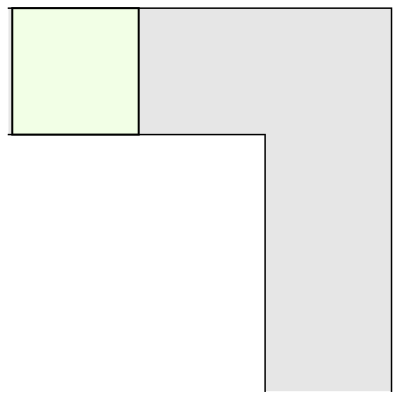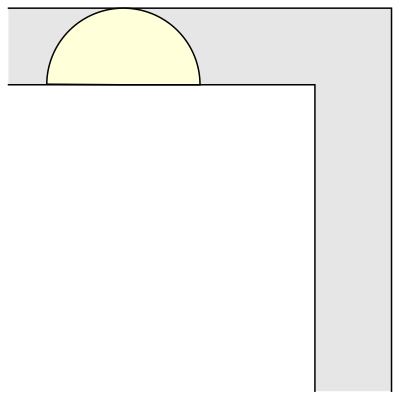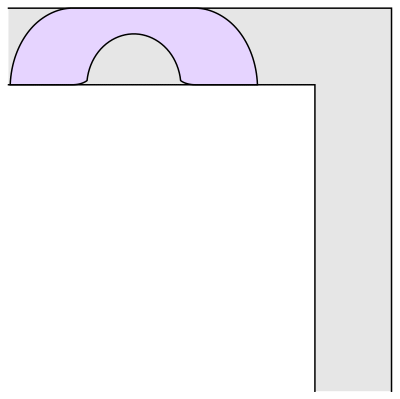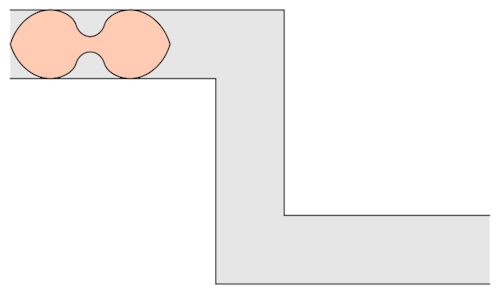The Complex Geometry Of Islamic Design
The Complex Geometry of Islamic Design
In Islamic culture, geometry is everywhere. You can find it in mosques, madrasas, palaces and private homes. This tradition began in the 8th century CE during the early history of Islam, when craftsman took preexisting motifs from Roman and Persian cultures and developed them into new forms of visual expression.

This period of history was a golden age of Islamic culture, during which many achievements of previous civilizations were preserved and further developed, resulting in fundamental advancements in scientific study and mathematics. Accompanying this was an increasingly sophisticated use of abstraction and complex geometry in Islamic art, from intricate floral motifs adorning carpets and textiles, to patterns of tile work that seemed to repeat infinitely, inspiring wonder and contemplation of eternal order.

Despite the remarkable complexity of these designs, they can be created with just a compass to draw circles and a ruler to make lines within them, and from these simple tools emerges a kaleidoscope multiplicity of patterns. So how does that work? Well, everything starts with a circle. The first major decision is how will you divide it up? Most patterns split the circle into four, five or six equal sections. And each division gives rise to distinctive patterns.

There’s an easy way to determine whether any pattern is based on fourfold, fivefold, or sixfold symmetry. Most contain stars surrounded by petal shapes. Counting the number of rays on a starburst, or the number of petals around it, tells us what category the pattern falls into. A star with six rays, or surrounded by six petals, belongs in the sixfold category. One with eight petals is part of the fourfold category, and so on.

There’s another secret ingredient in these designs: an underlying grid. Invisible, but essential to every pattern, the grid helps determine the scale of the composition before work begins, keeps the pattern accurate, and facilitates the invention of incredible new patterns. Let’s look at an example of how these elements come together.

We’ll start with a circle within a square, and divide it into eight equal parts. We can then draw a pair of criss-crossing lines and overlay them with another two. These lines are called construction lines, and by choosing a set of their segments, we’ll form the basis of our repeating pattern.

Many different designs are possible from the same construction lines just by picking different segments. And the full pattern finally emerges when we create a grid with many repetitions of this one tile in a process called tessellation.

By choosing a different set of construction lines, we might have created this any of the above patterns. The possibilities are virtually endless.

We can follow the same steps to create sixfold patterns by drawing construction lines over a circle divided into six parts, and then tessellating it, we can make something like the above.

Here’s another sixfold pattern that has appeared across the centuries and all over the Islamic world, including Marrakesh, Agra, Konya and the Alhambra.

Fourfold patterns fit in a square grid, and sixfold patterns in a hexagonal grid.

Fivefold patterns, however, are more challenging to tessellate because pentagons don’t neatly fill a surface, so instead of just creating a pattern in a pentagon, other shapes have to be added to make something that is repeatable, resulting in patterns that may seem confoundingly complex, but are still relatively simple to create.

This more than 1,000-year-old tradition has wielded basic geometry to produce works that are intricate, decorative and pleasing to the eye. And these craftsman prove just how much is possible with some artistic intuition, creativity, dedication along with a great compass and ruler.
More Posts from Matematicaulysses and Others





Puns are a SIN

Please remember not all formulas apply to all situations.

Project Euler has this problem called Laserbeam. It starts as one thing but leads somewhere completely different.

Cool !

Excelentes gifs


Bruno Munari, (1960), The Square, Translation by corrainiStudio, Corraini Edizioni, Mantova, (2006-)2011, pp. 62-63
#math #matematica #planificação #geometria #prof ulysses tdb #professor ulysses bueno

Matthew Shlian
More on the artist/paper engineer whose tessellation I posted yesterday. This post includes more work and two videos where he talks about his background and work. I love his intersection with literature, sculpture, and science.

If one remembers this particular episode from the popular sitcom ‘Friends’ where Ross is trying to carry a sofa to his apartment, it seems that moving a sofa up the stairs is ridiculously hard.
But life shouldn’t be that hard now should it?
The mathematician Leo Moser posed in 1966 the following curious mathematical problem: what is the shape of largest area in the plane that can be moved around a right-angled corner in a two-dimensional hallway of width 1? This question became known as the moving sofa problem, and is still unsolved fifty years after it was first asked.

The most common shape to move around a tight right angled corner is a square.
And another common shape that would satisfy this criterion is a semi-circle.

But what is the largest area that can be moved around?
Well, it has been conjectured that the shape with the largest area that one can move around a corner is known as “Gerver’s sofa”. And it looks like so:

Wait.. Hang on a second
This sofa would only be effective for right handed turns. One can clearly see that if we have to turn left somewhere we would be kind of in a tough spot.
Prof.Romik from the University of California, Davis has proposed this shape popularly know as Romik’s ambidextrous sofa that solves this problem.

Although Prof.Romik’s sofa may/may not be the not the optimal solution, it is definitely is a breakthrough since this can pave the way for more complex ideas in mathematical analysis and more importantly sofa design.

Have a good one!
-
 ohnoyizhan liked this · 1 month ago
ohnoyizhan liked this · 1 month ago -
 risagablog reblogged this · 2 months ago
risagablog reblogged this · 2 months ago -
 arbitrarysquiggles liked this · 2 months ago
arbitrarysquiggles liked this · 2 months ago -
 giga-men liked this · 3 months ago
giga-men liked this · 3 months ago -
 scavengermenace reblogged this · 3 months ago
scavengermenace reblogged this · 3 months ago -
 escapingtheirony liked this · 3 months ago
escapingtheirony liked this · 3 months ago -
 itriedtoescape liked this · 3 months ago
itriedtoescape liked this · 3 months ago -
 basterart reblogged this · 3 months ago
basterart reblogged this · 3 months ago -
 basterbinkers liked this · 3 months ago
basterbinkers liked this · 3 months ago -
 loveeevinegar liked this · 3 months ago
loveeevinegar liked this · 3 months ago -
 itzpapa-hoe-tl reblogged this · 3 months ago
itzpapa-hoe-tl reblogged this · 3 months ago -
 itzpapa-hoe-tl liked this · 3 months ago
itzpapa-hoe-tl liked this · 3 months ago -
 le-fils-de-lhomme liked this · 4 months ago
le-fils-de-lhomme liked this · 4 months ago -
 seaalien liked this · 4 months ago
seaalien liked this · 4 months ago -
 psychics-at-caltech reblogged this · 4 months ago
psychics-at-caltech reblogged this · 4 months ago -
 pheobecaulfield01 liked this · 4 months ago
pheobecaulfield01 liked this · 4 months ago -
 quantum-dragon reblogged this · 4 months ago
quantum-dragon reblogged this · 4 months ago -
 fagermeister liked this · 4 months ago
fagermeister liked this · 4 months ago -
 gomlet liked this · 4 months ago
gomlet liked this · 4 months ago -
 thelovingfriend liked this · 4 months ago
thelovingfriend liked this · 4 months ago -
 getuponyourgoodfoot reblogged this · 4 months ago
getuponyourgoodfoot reblogged this · 4 months ago -
 square-state-syndrome reblogged this · 4 months ago
square-state-syndrome reblogged this · 4 months ago -
 square-state-syndrome liked this · 4 months ago
square-state-syndrome liked this · 4 months ago -
 godisafujoshi reblogged this · 4 months ago
godisafujoshi reblogged this · 4 months ago -
 godisafujoshi liked this · 4 months ago
godisafujoshi liked this · 4 months ago -
 ripplesonreflections liked this · 4 months ago
ripplesonreflections liked this · 4 months ago -
 hexcrow liked this · 4 months ago
hexcrow liked this · 4 months ago -
 a-screeching-dragon liked this · 4 months ago
a-screeching-dragon liked this · 4 months ago -
 nyenke reblogged this · 4 months ago
nyenke reblogged this · 4 months ago -
 madhermit liked this · 4 months ago
madhermit liked this · 4 months ago -
 swimmingblue reblogged this · 4 months ago
swimmingblue reblogged this · 4 months ago -
 geminidark liked this · 4 months ago
geminidark liked this · 4 months ago -
 nothingtoseemoveon liked this · 6 months ago
nothingtoseemoveon liked this · 6 months ago -
 archedyketyon reblogged this · 6 months ago
archedyketyon reblogged this · 6 months ago -
 archedyketyon liked this · 6 months ago
archedyketyon liked this · 6 months ago -
 floundering-through-life reblogged this · 7 months ago
floundering-through-life reblogged this · 7 months ago -
 sjerzgirl liked this · 7 months ago
sjerzgirl liked this · 7 months ago -
 artrefo reblogged this · 8 months ago
artrefo reblogged this · 8 months ago -
 joshurequiem liked this · 8 months ago
joshurequiem liked this · 8 months ago -
 zekeen liked this · 9 months ago
zekeen liked this · 9 months ago -
 eattheacid reblogged this · 9 months ago
eattheacid reblogged this · 9 months ago -
 cryingunderthewaterfall liked this · 9 months ago
cryingunderthewaterfall liked this · 9 months ago -
 timeeaterforfun liked this · 10 months ago
timeeaterforfun liked this · 10 months ago -
 alice-grant-morgan liked this · 10 months ago
alice-grant-morgan liked this · 10 months ago -
 lebanish reblogged this · 10 months ago
lebanish reblogged this · 10 months ago
Blog do profº Ulysses TDBueno destinado a curiosidades, demonstrações, links, trabalhos, artigos, imagens e tudo que possa mostrar a matemática no mundo.
107 posts